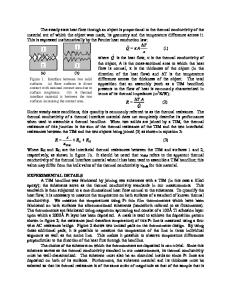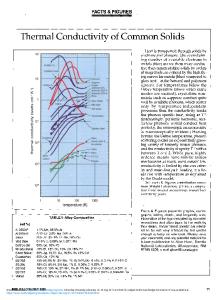Thermal conductivity of transition metal containing type-I clathrates
- PDF / 1,332,188 Bytes
- 9 Pages / 612 x 792 pts (letter) Page_size
- 76 Downloads / 335 Views
Thermal conductivity of transition metal containing type-I clathrates M. Ikeda1, X. Yan1, L. Prochaska1, G. Lientschnig1, R. Svagera1, M. Waas1, P. Tomeš1, A. Prokofiev1, E. Bauer1, and S. Paschen1 1
Institute of Solid State Physics, Vienna University of Technology, Wiedner Hauptstr. 8-10, 1040 Vienna, Austria
ABSTRACT Concerning a materials ability to convert heat to electrical energy, the electrical power factor S2/ρ as well as the thermal conductivity at elevated temperatures are of special interest. Since Flash experiments measure the thermal diffusivity and standard steady-state heat-flow experiments are inaccurate at elevated temperatures due to radiation errors inherent to this technique, direct and accurate thermal conductivity data on type-I clathrate single crystals at elevated temperatures are scarce in literature. Here we report 3ω thermal conductivity data on single crystalline Ba8Cu5.09Ge40.91 (BCG), La1.23Ba6.99Au5.91Si39.87, and Ce1.06Ba6.91Au5.56Si40.47 in the temperature range between 80 and 330 K, and specific heat data on BCG between 2 and 300 K. The comparison of our room temperature phonon thermal conductivity data (κph) to results on transition metal (TM) free type-I clathrates in terms of the guest free space (Rfree) suggests a stronger dependence of κph on Rfree for the clathrates containing TM elements. INTRODUCTION In 2013 more than 85% of the world energy consumption was covered by energy harvested from fossil fuel sources [1]. Pollution, global warming as well as the foreseeable depletion of these resources thus demand for the further development of alternative energy sources. Thermoelectric materials can convert waste heat directly into electricity. Therefore, they might play an important role in a future world energy balance. The efficiency of a thermoelectric material is benchmarked by the dimensionless thermoelectric figure-of-merit ZT = S2/(ρ(κph+κel))T, where S is the thermopower and ρ is the electrical resistivity. According to the Wiedemann-Franz law, the electronic part of the thermal conductivity (κel ) is proportional to the inverse electrical resistivity. Therefore, ρ cannot be tuned without affecting the thermal conductivity (κ). As a result, two main routes for improving ZT can be followed. On the one hand efforts to decrease the phonon thermal conductivity (κph ) can be undertaken, on the other hand routes to increase the electrical power factor α = S2/ρ can be studied. Type-I clathrates are a materials class with intrinsic low phonon thermal conductivity. However, although much investigated, the physical origin of this key feature is still debated. This may at least in part be attributed to the scarcity of accurate thermal conductivity data on single crystalline type-I clathrates. Thus, we have developed a measurement setup on the basis of the 3ω method as suggested by Cahill et al. [2,3], allowing for direct thermal conductivity measurements in the temperature range from 80 to 700 K. Here we report 3ω thermal conductivity results on the group 11 transition metal (TM) c
Data Loading...










